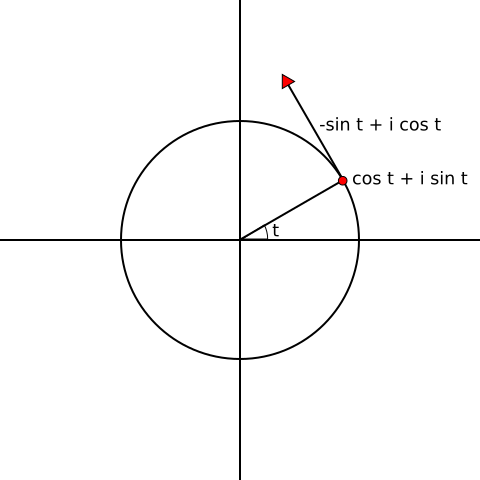How do hyperbolic sine and cosine relate to the hyperbola?
2 Answers
Here's an attempt to explain in slightly touchy feely terms. If I can formulate it a bit better I may provide another answer later.
Explanation:
The trigonometric functions
The hyperbolic functions
As conic sections, the unit circle and unit hyperbola are at right angles.
In fact the Real trigonometric and hyperbolic functions are just sections of the Complex
Consider the unit circle in the Complex plane and a point travelling around the circle with position

Hence we find
From these derivatives and the values
#sin x = x/(1!)-x^3/(3!)+x^5/(5!)-x^7/(7!)+...#
#cos x = 1/(0!)-x^2/(2!)+x^4/(4!)-x^6/(6!)+...#
These Maclaurin series are easy to prove convergent and very well behaved in general. We can use them to extend the definition of
#sin z = z/(1!)-z^3/(3!)+z^5/(5!)-z^7/(7!)+...#
#cos z = 1/(0!)-z^2/(2!)+z^4/(4!)-z^6/(6!)+...#
Then see what happens to these series when we substitute
#sin ix = i (x/(1!)+x^3/(3!)+x^5/(5!)+x^7/(7!)+...)#
#cos ix = 1/(0!)+x^2/(2!)+x^4/(4!)+x^6/(6!)+...#
So we find:
#cos ix - i sin ix = 1/(0!)+x/(1!)+x^2/(2!)+x^3/(3!)+...#
Define:
#exp(z) = 1/(0!)+z/(1!)+z^2/(2!)+z^3/(3!)+... = cos iz - i sin iz#
Then:
#exp(i theta) = cos(i^2 theta) - i sin(i^2 theta)#
#=cos(-theta) - i sin(-theta)#
#=cos theta + i sin theta#
If we define:
#sinh z = 1/i sin iz = z/(1!)+z^3/(3!)+z^5/(5!)+z^7/(7!)+...#
#cosh z = cos iz = 1/(0!)+z^2/(2!)+z^4/(4!)+z^6/(6!)+...#
then we are basically just rotating the axes of the coefficients through a right angle.
#cosh(x) = (exp(x) + exp(-x))/2#
#sinh(x) = (exp(x) - exp(-x))/2#
These identities continue to work for Complex values too.
The parametric equation
#{(x = cosh(t)),(y = sinh(t)):}#
defines a unit hyperbola.
This arises from the identity
#cosh^2(x) - sinh^2(x) -= 1#


